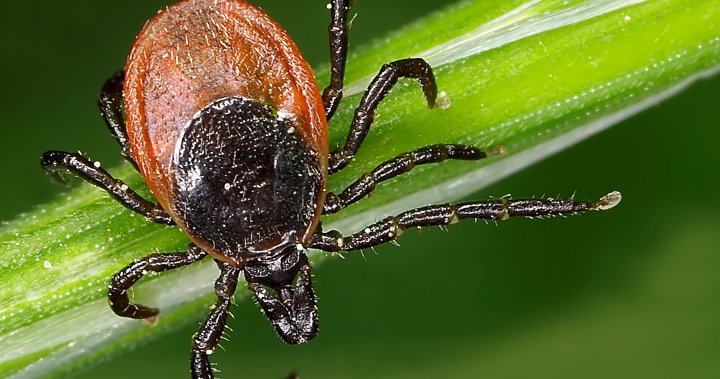Canada’s warming temperatures signal the arrival of spring and blooming flowers, but they also stir ticks from their winter hiding spots, poised to latch onto unsuspecting hosts after months of inactivity.
Given the unseasonably warm winter experienced in many parts of the country, experts caution that these ticks likely emerged weeks ago, primed and ready to strike.
“Ticks have started. They only need about 4 C and they’re active and they’re questing,” explained David Beresford, an entomology professor at Trent University in Oshawa, Ont. “They want to grab on and they want to bite.”
Warmer temperatures and shifting weather patterns have created more favourable conditions for ticks to thrive and expand their habitats across Canada. This expanding range brings them into closer contact with humans and animals, heightening the risk of tick-borne illnesses.
Lyme disease is the most common tick disease in Canada and is primarily spread by deer ticks. It’s been on the rise in Canada over the last decade due to climate change. It’s caused by a bacteria called Borrelia burgdorferi and is transmitted through the bites of infected deer ticks.
In 2022 there were 2,168 reported cases of Lyme disease across Canada – up from just 144 cases reported in 2009, according to the latest Health Canada data.
During a Canadian winter, ticks seek shelter in protected areas like leaf litter or under logs, or burrow under the snow and into the soil to stay insulated.
As temperatures begin to rise — typically around 4 C — ticks become active again. They emerge from their winter hiding spots and start seeking hosts for blood meals. In Canada, the timing of tick activity can vary depending on the specific region and local climate conditions. Balmier temperatures and increased humidity generally trigger their emergence, according to Beresford.
He warned that although it may still feel cold in parts of Canada, ticks can still be active.
“It’ll still feel cold, you’ll still think it’s kind of winter … you’ll have a coat on and the ticks are out,” he said. “You can’t just wait until the spring feels like springs to worry about ticks. I would say this is right now a very vulnerable time to be exposed to ticks.”
The latest health and medical news
emailed to you every Sunday.
He suggested Canadians might be at risk currently because, typically, people don’t associate ticks with March and often consider them a concern only during summer hikes.
However, Beresford said as ticks emerge from their winter shelters they’re very actively in search of food, potentially posing a threat to unaware individuals.
“They’re hungry for a blood meal to provide for their eggs,” he explained. “It’s a very strong reproductive drive that’s impelling them to want to latch.”
Ticks are expanding their range in parts of Canada at a rate of 46 kilometres per year, according to TickTalk Canada. With this expansion comes an increased risk of pets and people encountering ticks and the diseases they may carry, such as Lyme disease.
These arachnids live mostly in wooded areas but can also be found in cities because they hitch rides on birds, mice and deer. They can be found in parks, green spaces, trails and backyards.
The Public Health Agency of Canada (PHAC) warned that rising temperatures not only extend the survival and activity window for ticks but also broaden the range of hosts, like mice and deer. This increases the period when people are at risk of encountering ticks.
A warming climate and other environmental changes have contributed to the expansion of the range of several tick species into higher latitudes in North America, PHAC said. As temperatures rise across Canada, the environment becomes increasingly favourable for ticks, extending the season of their activity. Consequently, PHAC said, tick-borne diseases are likely to become more common in the country.
In addition to Lyme disease, PHAC warned that four other tick-borne diseases have started to emerge and are likely to increase: anaplasmosis, babesiosis, powassan virus and Borrelia miyamotoi disease.
With tick-borne illnesses on the rise nationwide, Dr. Maggie Brown-Bury, a veterinarian from Newfoundland, urged Canadians to prioritize protection for both themselves and their pets while outdoors.
“Ticks don’t follow seasons, they follow temperatures,” she said. “And any time we have a day that’s above 4 C, black-legged ticks, which can carry Lyme disease, are going to be active.”
To protect yourself from ticks, especially when spending time outdoors in areas where they are prevalent, she recommended wearing long-sleeved shirts and long pants tucked into socks or boots to create a barrier against them.
Additionally, applying insect repellents containing DEET to exposed skin and clothing can provide protection. Stick to cleared paths and steer clear of tall grasses or dense vegetation, where ticks tend to lurk.
When it comes to your pet, Brown-Bury suggests using a tick repellent, but she advised consulting a veterinarian first, as some products effective for dogs can be toxic to cats.
“So knowing which product is the safest for your household is important,” she added.
She also recommends conducting a tick check on both yourself and your pet upon returning home.
According to Health Canada, when you come home from being outside, you should check your entire body, such as your head and hair, in and around the ears, under the arms, behind the knees and even between the toes.
If you do find a tick, use clean fine-point tweezers to slowly pull it straight out. Wash the bite area with soap and water or an alcohol-based sanitizer and contact your health-care provider if you are not feeling well.
Beresford stressed that although tick season is here, he does not want that to dissuade Canadians from going outside and enjoying the weather.
“We need to get outside too. And it’s not that hard to inspect, just be aware of it,” he said. “(A tick check) takes 10 minutes, just look around and use a mirror to see if you have ticks.”




